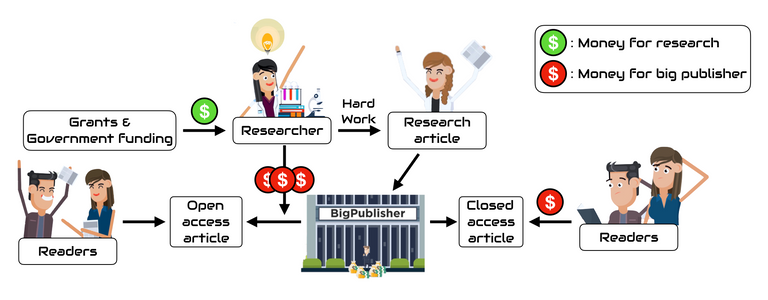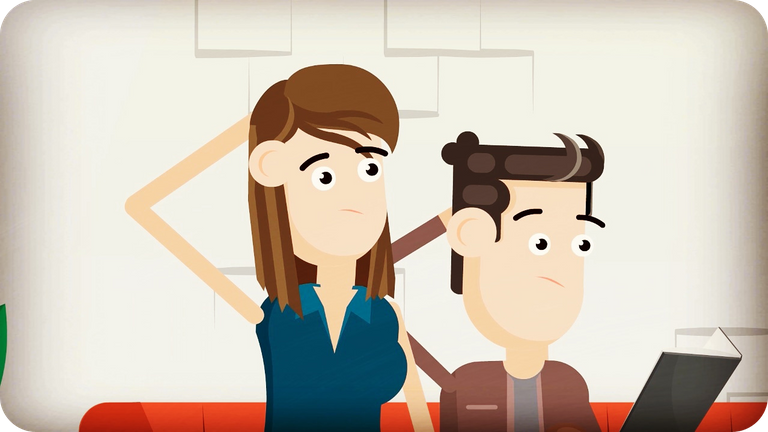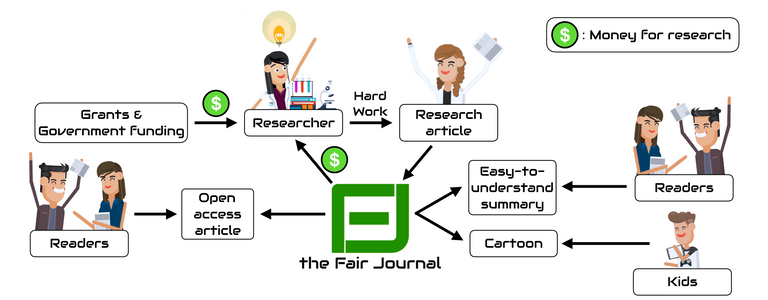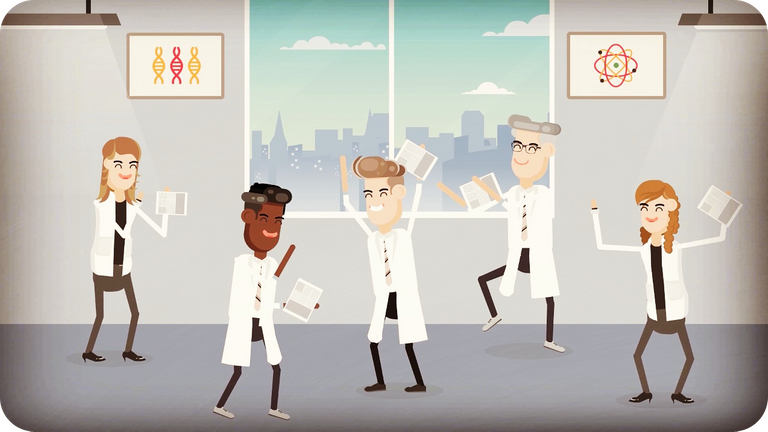What is the Fair Journal?
The Fair Journal is an online publishing platform for scientific articles. What distinguishes the Fair Journal from other scientific journals is a focus on paying scientists what is fair, and on spreading science to non-scholarly educated adults and kids. The following video explains the concept behind the Fair Journal:
We publish 3 versions of an article: one for scientists, one for adults, and a cartoon version for kids. The cartoon version is a short animation similar to the one you have watched in the video above. It will explain the essence of the research to kids, with a focus on storytelling and making it fun. The one for adults have more details and explanations, and it is written in a language that non-scholarly educated people can understand. We will soon post some examples here on Steem, but until then you can already have a look at https://thefairjournal.com where there is already five cartoons.

Why do we need the Fair Journal?
As technology advances, people are able to access information across a wide variety of platforms, including television, newspapers, and websites. But as access to information grows, so does the proliferation of inaccurate or untruthful information. For the average person, it can be difficult to decipher what is true and what is not, especially when it comes to subjects they may not be well-versed in, such as science. We hope to combat inaccurate scientific information being shared with the general public by giving a more digestible version of scientific research so that people are better informed and better able to discern between truthful and inaccurate information. Additionally, by making a version for kids, our hope is that they may grow up being smarter, more critically thinking, have better ideas to solve the problems of the future, and be more innovative than previous generations.

How the scientific publishing system currently works
As it is today, scientific publishers do not pay scientists for their work. In contrast many actually charge the scientists to publish their work (often ~1500-3000$, examples from PLOS here. Additionally if scientists want their article to be open access (meaning that people do not have to pay to read the article) they have to pay a sky-high fee (often ~2000-5000$, see examples from Nature here). Here is a schematic overview of the current situation:

In order to get research funding it has become an (unwritten) rule that the scientist must publish high impact factor papers (i.e. publish in very few specific journals). Therefore, the future of individual scientists is in the hand of a very small group of people known as science editors. Given that the main way to stay in science is through publishing in these journals, the editors are swamped with submissions, and have very little time to read a manuscript. So often the scientists get an unfair treatment. Due to the dependency on these journals, the publishers can charge whatever fee they like for publishing the scientists’ work.
In order to satisfy and impress the journal editors, scientific articles are written in a very sophisticated manner with lots of abbreviations and jargon from specific fields. Therefore, science articles have become impossible to understand for non-scholarly educated people, and are even very difficult to understand for scientists from another field.

But how is it possible to pay scientists for their work when no other publisher does?
The payment system of the Fair Journal is based on a similar system as what is used on Youtube. There will be commercials on the site, and every time someone views an article, the companies pay a small amount. This means that the more readers an article has, the more money the researchers will be paid. Here is a schematic overview of how the Fair Journal's publication system works:

We will pay 55% of the ad revenue to the authors directly for a full research manuscript (the same as Youtube), and 25% for a layman summary. The rest of the revenue will be used to pay salaries, servers, expansion, and reviewers. The Fair Journal’s payout will last the lifetime of an article. This means that at the end of a career scientists may have hundreds of articles published, which all provides money for research.
By using this strategy, it is our hope that some researchers may become completely independent of grants and impact factors in the future.

The benefits of the Fair Journal compared to other publishers
- Spreading science to kids and non-scholarly educated adults
- Scientists will earn money from their scientific articles or layman summaries
- Complete and free open-access, meaning that you never have to pay anything to read the articles.
- No publication fees
- Royalties can be used as the researcher sees fit (we suggest using them for exploratory research)
The disadvantages of the Fair Journal compared to other publishers
- We are not a well-known publisher in 2019, and scientists may still prefer more well-known journals.
- We are not yet indexed on PubMed, Web of Science etc. and we do not have an ISSN. This is only possible after publishing a full issue with 25 peer-reviewed articles.
- There will be ads on the homepage (but other publishers like Nature, Science, and Cell also have ads on their sites – they just do not share the revenue with the scientists)
Submit your manuscript or layman summary
The Fair Journal accepts two different types of submissions:
- A full research manuscript (will undergo normal peer review)
- A layman summary of already published work (must be from one or more of the original authors)
Given that submission of a full research manuscript may be too risky at the moment, we hope that researchers will at least see the 2nd type of submission as a good opportunity to spread their research findings to more people.
The two types of submissions have different payment levels. For a full research paper authors will receive 55% of the revenue. For a layman summary of an article published elsewhere, authors will receive 25% of the revenue. For both submission types the revenue coming from the cartoon will of course also be counted.
Currently there are three ways that an article/layman summary will enable cartoon production:
- Unbiased way: Automatic when the article/summary has earned 100$ (1/3 of current average production costs for a cartoon)
- Biased way: Articles/summaries that we really love!
- Paid way: You pay 300$ (current average production costs for a cartoon). If you do this you will get 55% of the revenue instead of 25% when you submit a layman summary.
Risks and Challenges
The biggest challenge for the Fair Journal is to get scientists to trust the journal and start submitting their articles. However, since we are aiming at both 1) getting scientists paid fairly, and 2) sharing the scientific knowledge with adults and kids, we would still be able to publish cartoons and easy-to-understand summaries of articles published elsewhere. The only problem with this is that we would not be able to re-publish figures from the original articles, as they would belong to the journal that originally published the work. But to circumvent this, we can still ask the authors for an alternative version of a figure, or make a new one to illustrate the findings.
Please give us your feedback
As we are just starting up here in 2019, we would be happy to hear your feedback on the concept. So please post your comment below, or get in touch on https://thefairjournal.com/contact/
I really like the outreach part of the project. Really. This is a bit what I personally try to do here on Steem (making my field of research more understandable to everyone), and we should habe more of such initiatives.
However, what you say with respect to the publishing system is not entirely true. There are many very good open access initiatives (where also referee reports are sometimes open). Moreover, the arxiv is also a great initiative for having all articles available even before being submitted to a journal. All of this is free, open access, etc.
In my opinion, the articles are hard to understand because they are written for peers (and not to impress the editors at all, who are by the way also peers). Peer-review is what assesses the quality of the articles (and not the editor alone). Moreover, non-scholarly people are not those people supposed to read these published scientific articles. For them, blogs may be better options to get an essence of what is going on (and some, although not enough, exist).
Personally, and this is maybe the most important part for your initiative, I won’t submit any article to the Fair Journal. The reason is that I cannot find any information about the editorial team, the referral system that is used, guidelines for authors, etc. In other words, I cannot find the ‘step 0’ that will allow me to start building some trust to the initiative.
PS: just to be clear, I am all in favor of the outreach part but much more skeptical for the scientific journal part.
Some good points, we've debated a few times before actually but I'll repeat here a little: though many are open access, during my active days writing on Steem I found the vast majority of papers I needed to access were behind a wall of subscription fees and other high-priced gateways. It was often a struggle.
There may be plenty out there open access, particularly in some fields such as your own, but this doesn't remove the fact that there are plenty that are not.
I totally agree with the latter part of the comment though, this initiative needs to be much more open to what it is and who's behind it all, but I guess this shouldn't be something that takes more than a few hours to sort out, if thefairjournal agrees with the sentiment
The open access issue is a field dependent stuff. In my field, the entire community is behind open-access (and open source on different matters). This is of course not a general case, although in principle it should be. Whether other fields will follow... this the future will tell us. But in any case, the motivation must come from the inside on a given community, or it won't work.
Hi Mobbs, sorry I missed your comment. I think it came while I was busy answering lemouth.
I will for sure work on making the information about the actual full manuscript submission more complete and transparent. I guess it has been neglected a bit, due to focus on the outreach part. And maybe I have been a scientist so long, that I thought instructions to authors were a bit unnecessary (I'm in my 8th year as a postdoc). It does say under the submission page which sections a manuscript should contain, but not more than that: https://thefairjournal.com/submit-your-full-research-manuscript/
Regarding an editorial board, I think it will be difficult to gather one at the moment without having had success with the outreach. Also because we are for now aiming very broad and accepting manuscripts/layman summaries from any field. But since many scientists see journals by the value of their editors it is perhaps a necessity to have a board in place before any scientist would consider submitting. But for now, I could put myself down at least, and then start to ask around if anyone else would be interested in helping out. So if anyone that reads this think they are capable, please get in touch! :)
Cheers,
Jonas
Hi Jonas,
For the reasons you mentioned, I would focus on the outreach part only. There is nothing with this respect on the market (at least to my knowledge) and I really think the idea is good. When you get there, you should then consider diversifying. But before that, you would need to make your brand known and recognised. It is easier to do so through a domain (outreach) where the competition is less fierce.
Consequently, I would remove any mention of "regular" publications from the website.
Cheers!
Hi lemouth, thank you for your feedback! I also appreciate what you do on Steem :)
I agree that there are more and more good options for scientists to get their research out without paying anything. I really like what bioRxiv and arXiv are doing! And it is great that more and more scientists are using this. There has also previously been at least one attempt to pay scientists for their articles. But they failed due to not being viable in the long run (sorry I don't find the reference for it right now). In my opinion it will only be viable if a lot of people are interested, hence, it is not enough that only scientists find it interesting. And that is what I try to circumvent with the cartoons. The journal that attempted this before were paying a flat rate, whereas we would pay a percentage. So in that sense it will never lead to a deficit, and could therefore be more viable than with a flat rate. It would of course also mean that if it goes really well for an article, the scientists would be paid much more than they would have been from a flat rate :)
I understand what you mean about articles being difficult to understand because they are written specifically for peers. But I have seen many times that scientists use very fancy words in order to sound sophisticated. For instance the example I give in the intro cartoon: Instead of writing "the protein was located next to the nucleus" some would write "the protein occupied a juxtanuclear position". This means completely the same thing, but many would not understand the latter. And it is this type of language use I would like to minimize.
I also realize that the major caveat right now is getting full research manuscripts, as we do not have the normal things in place that a scientist usually looks for. Such as editorial board, author guidelines, etc. I think what most other scientist are asking for has been database indexing, ISSN etc, but those things are not possible to get until some articles has been published. So it's a bit of an evil circle that scientists will not submit until those things are in place, and we cannot get those things in place before scientists start to submit. We did try to circumvent this by allowing scientists to just submit layman versions of articles published elsewhere (and still pay them part of the revenue for that). That would of course still not allow indexing and ISSN, but at least it would get the ball rolling and create more awareness of the concept.
But thanks again for your feedback, and I'm happy to discuss more!
Cheers,
Jonas (creator of the Fair Journal)
Please see my reply above ;)
Interesting concept for sure. We have seen many variants of attempted solutions to the pricing of research come and go on Steem and other Ethereum based tokens, and we often never hear from them again. Do you believe you have a model that can function long term already?
More importantly for me and SteemSTEM, how do you think this - or any - blockchain will contribute to your cause, outside of being another place to share your content? Assuming you get some revenue from posting here, what would you do with it?
Thank you Mobbs! I think my model would be able to function in the long run. I have heard from teachers that they are very interested in something like this, and may even be interested in implementing it in the curriculum. So if that happens, it would be a steady number of viewers every month. But of course we are still far away from this.
The most obvious answer to how SteemSTEM will contribute, is that I may be able to generate more revenue to produce more cartoons (which is the only thing that requires funding right now). But the blockchain technology is also perfect for documenting scientific results, as it will not be possible to manipulate it, like it otherwise in theory would be on any normal website. So with the blockchain technology we have sort of a modern laboratory notebook where you always can look back to check that everything is kosher.
The revenue I would get from here, I would use to make more cartoons. And hopefully more cartoons would mean more interest in the journal, which would mean even more revenue for even more cartoons, and so on.
Cool. Our value is not great now with the steem prices we have, but maybe itll be worth something down the line =)
Let's hope so :)
I like the concept behind this work, if it gets other scientists support is yet to be seen
What a most wonderful initiative @thefairjournal :)
Provide people with psychology evidence-based information has been a mission I have humbly adopted.
The idea to present scientific studies through cartoons is beautiful! I love cartoons. They make the topic more inviting and less intimidating :)
I wish you the best of luck with your project!
Welcome to Steemit & Steemstem.
Abigail
Thank you Abigail!
We hope that not only kids, but also adults will enjoy the cartoons. And perhaps it will peak their interest to read a bit more about the scientific topics (in the layman summaries).
I'm excited to see how well our content will be received here on Steemit and Steemstem!
Cheers,
Jonas
Thanks for sharing informative blog.
Congratulations @thefairjournal! You have completed the following achievement on the Steem blockchain and have been rewarded with new badge(s) :
You can view your badges on your Steem Board and compare to others on the Steem Ranking
If you no longer want to receive notifications, reply to this comment with the word
STOPVote for @Steemitboard as a witness to get one more award and increased upvotes!
👍
~Smartsteem Curation Team
This post has been voted on by the SteemSTEM curation team
and voting trail. It is elligible for support from @curie and @minnowbooster.
If you appreciate the work we are doing, then consider supporting our witness @stem.witness. Additional witness support to the curie witness would be appreciated as well.
For additional information please join us on the SteemSTEM discord and to get to know the rest of the community!
Please consider using the steemstem.io app and/or including @steemstem in the list of beneficiaries of this post. This could yield a stronger support from SteemSTEM.